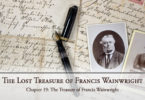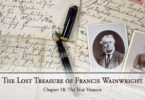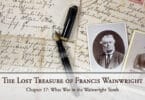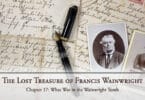The elderly woman behind the desk at the entrance to the Ipswich Town Hall looked like she might have been there since the town was founded, four centuries ago. She was also smiling and pleasant and seemed happy to have visitors. The Town Hall was quiet, and the cousins didn’t see any other people in the entrance area. They all got the impression that members of the public rarely came here. The woman was probably excited to finally have something to do to break up her day of reading old paperbacks and playing solitaire on the antique computer on the desk behind her, by the window.
“Hello,” Christine began, speaking for all of them. “We were wondering, do you have any information on the history of the ancient burying ground here in town?”
“What kind of information are you looking for, dear?” the woman asked, putting both hands on top of the countertop that separated the cousins from her work area. She gave them all a friendly smile.
“Um… maybe something that has descriptions of headstones and old tombs?” Christine posed her statement as a question because there were really so many different potential sources for the kind of information they needed. “We are specifically looking for a history of the Wainwright family tomb.”
“We’re descendants,” Grace helpfully added.
The woman thought for a moment. “We do have some old maps of the cemetery here,” she told them. “Some of them go back to the early 1700s, and the older ones have drawings on them, indicating what certain tombs looked like if they were any different from the usual headstone. Typical headstones have their own, uniform illustrations, too.”
Christine nodded with enthusiasm. “Yes, that. We need that. All the way from the earliest maps you have, to, say, the mid-1800’s. At the beginning of the age of photography.”
“Very well,” the old woman said, happy to help the group of young people. “I will get them for you. I’m afraid there isn’t a good place for you to sit and look at them, though. As you can tell, we are a bit short on tables and chairs. There’s no one else in line, though, and unlikely to be, unless we get someone coming in looking up old records for their genealogy. You are welcome to use the counter here as best you can, or sit on the floor so you can smooth out the maps better. You don’t have to worry about damaging them. They are all copies of the originals. The originals are all kept in climate-controlled conditions at the archives.”
She disappeared into the cavernous area in which she worked for a while, then returned about five minutes later with a stack of manila folders, each numbered with a year, and with a folded map inside. There must have been more than two dozen of them, probably around thirty, if Christine was guessing.
The cousins decided to each take a few of the maps, and together, they used up just about every inch of open floor space in the entryway, sitting cross-legged on the floor with their stack of maps in front of them.
The earliest maps were from before Philippa and Francis died, so they were of no use. However, around 1703, things started getting interesting. They could tell, thanks to Adam, who discovered it on one of his maps, that the Wainwright family tomb… the one with the door in the hillside….was built during that year. This meant it was built well after Philippa died, and shortly after Francis joined her.
Philippa was definitely inside the tomb, because a map from the 1670s, around the year she died, indicated she was buried without a marker in the place where the tomb now stood. Even Francis was buried in the tomb beside her, as per his wish (which was not surprising), meaning the large, ornate box-style marker for him in the open part of the cemetery was a cenotaph….a marker for people to commemorate and remember an important person, but without actual human remains in or under it.
“Francis Wainwright was an important man in Ipswich in those days,” Emily reminded everyone. “It is only natural that he would want to be buried next to Philippa, as she was his true love. But, it is also only natural that the people of the town, or his immediate family, would have wanted some other marker they could have out in the open to remember him by.”
“Then, why didn’t they put the marker up for him over the place where he is actually buried?” James asked. “The tomb wasn’t built over that spot yet when Francis died. With Philippa there, it would have been easy to put up a marker for both of them.”
“Most women didn’t rate that kind of recognition back then,” Grace said sadly, shaking her head. “And as for the tomb, I would guess Francis and Philippa’s children or grandchildren were already making plans to build it when Francis died. Francis probably knew about it and asked that they place a marker for him elsewhere, if they were so inclined. He had already commissioned the monument to Philippa, so he knew that was going up where the tomb was, and that was all that mattered to him. I suppose. It makes sense.”
“It does make sense,” Adam agreed. “All Francis cared about was commemorating Philippa. He wouldn’t have cared about his own marker. He didn’t even mention it in his will. The cenotaph is all his children or grandchildren’s doing. I actually like knowing he’s in the tomb next to Philippa. Once I found out how devoted they were to each other, it seemed wrong for them to be apart, even by just the few yards between the tomb and the cenotaph in the cemetery.”
His sibling and cousins concurred.
The maps had a break between 1703 and 1733, but the 1733 one that Emily was holding had something intriguing on it that was not on previous maps. A statue at the entrance to the Wainwright tomb.
It had to be Philippa. A quick check of later maps showed the statue again and again, until the 1780 map (there was a break again between 1764 and 1780), when it disappeared. All subsequent maps showed no statue.
“So, the statue was there,” Christine said, amazed. “Erected sometime between 1703 and 1733… closer to 1703, I would guess. But, where did it go?”
“And, why?” Grace wondered.





